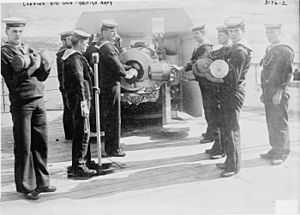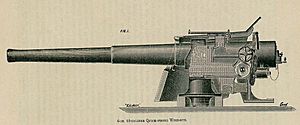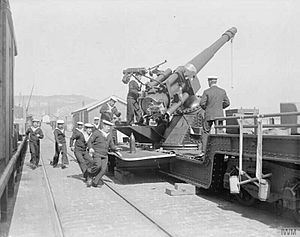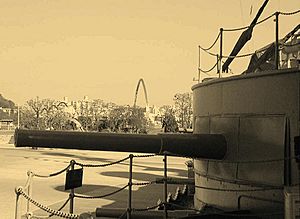QF 6-inch naval gun facts for kids
Quick facts for kids QF 6-inch 40 calibre naval gun15 cm/40 (6") 41st Year Type |
|
|---|---|

Typical naval deck mounting. An early long cartridge case for gunpowder propellant is upended at bottom left, a shell stands next to the cartridge.
|
|
| Type | Naval gun Coast defence gun |
| Place of origin | United Kingdom licence-produced in Japan |
| Service history | |
| In service | 1892–1945 |
| Used by | Royal Navy Imperial Japanese Navy Chilean Navy Italian Navy Argentine Navy United States Romanian Navy Royal Canadian Navy |
| Wars | Russo-Japanese War World War I World War II |
| Production history | |
| Manufacturer | Elswick Ordnance Company Royal Arsenal, Woolwich |
| Specifications | |
| Mass | 6.6 tons |
| Barrel length | 240 inches (6.096 m) bore |
|
|
|
| Shell | QF, separate cartridge and shell |
| Shell weight | 100 pounds (45 kg) |
| Calibre | 6 inch (152mm) |
| Elevation | -5 / +20 degrees |
| Traverse | +150 / -150 degrees |
| Rate of fire | 5-7 rounds per minute |
| Muzzle velocity | 2,154 feet per second (657 m/s) 820 feet per second (250 m/s) for anti-submarine shells |
| Effective firing range | 10,000 yards (9,140 m) at 20°elevation; 15,000 yards (13,700 m) at 28°elevation |
The QF 6-inch 40 calibre naval gun was a powerful weapon used on many ships built in the United Kingdom around the late 1800s and early 1900s. "QF" stands for "Quick-Firing," meaning it could shoot faster than older guns.
In the UK, these guns were known as the QF 6-inch Mk I, II, and III. Japan also used a version called the "15 cm/40 (6") 41st Year Type naval gun." This gun was so strong that it was the heaviest gun ever put on a destroyer before the Cold War. It played a role in major conflicts like the Russo-Japanese War, World War I, and World War II.
Contents
How the Gun Was Designed
Quick-Firing Technology
These guns were designed to use a new "Quick-Firing" (QF) method. With QF, the gunpowder (propellant) came in a brass case with a primer at its base. This brass case helped seal the back of the gun (the breech) when it fired. This design made the gun lighter and allowed it to shoot much faster than older guns. Older guns used cloth bags for gunpowder, which took more time to load.
The Mk I gun was built by Elswick, a company known for making weapons. The Mk II was made by the Royal Arsenal and was the first British Navy gun to use a special "wire-wound" construction, making it stronger. The way the gun was loaded was also improved, making it quicker to open and close the breech.
Recoil System
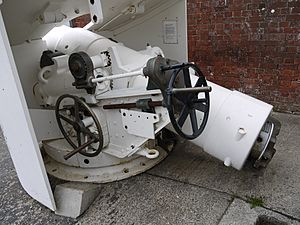
When a gun fires, it kicks back with a lot of force. This is called recoil. Older 6-inch guns used a system where they would slide backwards and upwards to absorb this kick. The QF Mk I and II guns had a new system. They used special parts called "recoil buffer" and "hydrospring recuperator" cylinders. These parts allowed the gun to recoil straight backwards and then return to its loading position. This is similar to how modern guns handle recoil.
The Mk III gun was like the Mk I but had special mounts called "trunnions." This allowed it to be used on older recoil systems that were still around. All three versions (Mk I, II, and III) had the same size and power.
Where the Gun Was Used

The QF 6-inch guns were a very important part of many Royal Navy ships. They were used as "secondary armament" (meaning not the main, biggest guns) on battleships from the 1890s and on cruisers until 1905. Ships like the Diadem, Powerful, and Edgar classes used many of these guns. Some battleships, like the Royal Sovereign and Majestic classes, carried up to 12 of these powerful guns.
On Land During the Second Boer War
During the Second Boer War (a conflict in South Africa), one of these naval guns was taken off a ship called HMS Terrible. It was put on a special carriage that could be moved by train. This allowed the gun to be used on land to help the British Army. It fired at enemy guns and even a searchlight from very far away. However, because the gun weighed 7 tons, it was very hard to move around on the battlefield. Two other guns were also put on armored trains and used by soldiers.
Protecting the Coasts
Starting in 1894, some of these guns were changed to be used for defending coastlines. Their loading mechanisms were updated to make them fire even faster. By 1918, 19 of these guns were still being used to protect the UK's coasts in places like Jersey, Guernsey, and the River Clyde.
Anti-Aircraft Gun in World War I
During World War I, at least one of these guns was put on a railway car. It was used as an improvised anti-aircraft gun to protect docks from enemy planes.
Changed into Howitzers
In World War I, Britain needed more heavy artillery on the Western Front. So, many older 6-inch naval guns were changed into 8-inch howitzers. A howitzer is a type of artillery that fires shells in a high arc. Sixty-three QF 6-inch Mk II guns were shortened and made wider to become the BL 8-inch howitzer Mk V. These new howitzers started being used in 1915 and 1916.
Used by Other Countries
Italy also used these guns, calling them "Cannone da 152/40 A Modello 1891." They were on many Italian warships, including armored cruisers and battleships. These guns saw action in the Italo-Turkish War and World War I.
The Japanese Navy used a slightly changed version of this gun, called the Type 41 naval gun. It was designed by the same British company, Armstrong Whitworth. These guns were the main secondary weapons on Japanese battleships and the main guns on some cruisers. They were used in the First Sino-Japanese War, Russo-Japanese War, and World War I.
The Type 41 gun fired a 100-pound shell. Different types of shells were used, including those that could pierce armor or explode on impact. Later, a heavier 113-pound shell was developed to attack submarines.
Two Romanian scout cruisers, Mărăști and Mărășești, each had three of these guns. Even though these ships were later called destroyers, they kept their 6-inch guns for many years. This made the QF 6-inch gun the heaviest artillery ever put on a destroyer before the Cold War.
United States Service

The United States Army also used a small number of these guns for coastal defense, especially during the Spanish–American War in 1898. They were worried about the Spanish fleet attacking US ports. These "6-inch Armstrong guns" were placed in forts along the coast. Some were later moved to Hawaii. Two of these guns can still be seen today at Fort DeSoto in Florida.
Canadian Service
These guns were on the ship HMS Niobe when it was given to Canada in 1910 and became HMCS Niobe.
Guns You Can Still See Today
- On board the Japanese battleship Mikasa in Yokosuka, Japan.
- Two coast defense guns at Fort DeSoto, Florida, USA.
- A Mk III gun and shield from HMS Calypso at Fort Nelson, Portsmouth, UK.
- Two guns on display at Howe Military Academy in Howe, Indiana.
- Two guns, originally from HMS Gibraltar, set up on the island of Vementry, Shetland, during World War I to defend a naval anchorage.
Similar Guns
- 15 cm SK L/40 naval gun (German equivalent)
- 6"/40 caliber gun (US equivalent)


